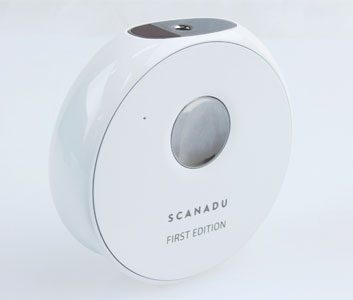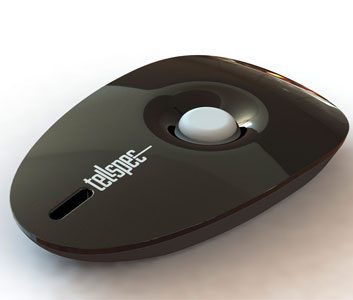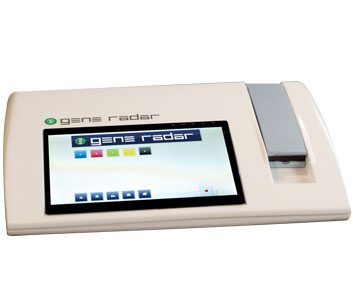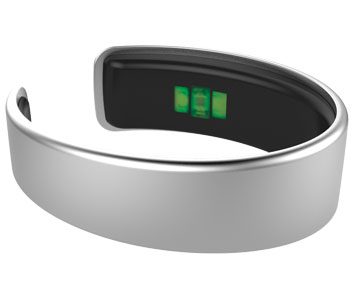
Scanadu Scout
How it works: Electrocardiograms (ECGs) used in hospitals measure the heart’s electrical activity via small electrodes attached to the skin; Scanadu has fit that ECG technology into a sensor the size of a hockey puck. When you hold the Scanadu Scout by your forehead for 10 seconds, sensors read and record your vital signs. The device measures heart rate, body temperature, oxygen saturation in the blood, respiratory rate, blood pressure and the heart’s electrical activity. This information is then beamed to the user’s smartphone app using Bluetooth LE. It shows patterns in the data over time.
How it will help people: The information can be especially helpful to those who need to monitor their heart and lung health; who have cardiovascular disease or emphysema; or who are recovering at home after major surgery. As Walter de Brouwer, CEO of the U.S.-based Scanadu, explains, “The only tool we have at home right now is the thermometer and maybe a blood pressure monitor, but there are so many other important health parameters.” Understanding what your numbers are, he adds, will lead to “improved conversations with your doctor.”
Expected to be for sale in North America: Currently, the company is working to finalize a version for submission to the U.S. Food and Drug Administration.
Projected retail cost: US$199

TellSpec
How it works: A spectrometer can identify a food item’s ingredients by sending light toward it and then measuring the light wavelengths that are reflected back. TellSpec combines a spectrometer with a database that includes information about thousands of ingredients and additives. So when the smartphone-size gadget scans the food on a restaurant plate, for example, it can identify the presence of gluten, egg and dairy molecules, and more.
How it will help people: Canadian IT and health entrepreneur Isabel Hoffmann launched Toronto-based TellSpec after her daughter developed gluten intolerance as well as other allergies to various chemicals such as food dyes. The laser-like device will also be able to detect the top allergens as defined by the U.S. Department of Agriculture (USDA), and will serve as an aid to nutrition labels for people with food allergies (especially important in foreign countries, where language can be an issue). It has broader applications, too. In seconds, TellSpec can determine the amount of fat, trans fats, sugar, proteins and calories in a food, which can help consumers make better choices. “The major application may be in weight loss and diabetes,” says Hoffmann.
Expected to be for sale in North America: The company is currently working on a timeline to deliver the product to consumers.
Projected retail cost: $400

Nanobiosym Gene-Radar
How it works: The Gene-Radar contains a tiny, built-in digital nanochip that can be programmed to recognize DNA markers of viruses and bacteria including influenza, HIV and tuberculosis, explains Dr. Anita Goel, chairman and CEO of U.S.-based Nanobiosym. To use it, the person pricks their finger, places a drop of blood on a disposable strip, and inserts the strip into the iPad-size device. The Gene-Radar then gives a diagnosis based on the type of bacteria or virus it recognizes in the blood.
How it will help people: By reducing the cost and turnaround time for diagnostic tests (down to an hour, from weeks or months), the Gene-Radar will allow patients to seek treatment faster. In the near future, Nanobiosym plans to test its product in African hospitals with high disease burdens, and to collaborate with U.S. hospitals. Then the company plans to roll out a model that can be purchased on shelves and used at home. This way, people will be able to diagnose their nagging cough or fever at home, “bringing the pathology lab to the individual,” as Goel puts it. (Of course, the Gene-Radar will not be able to recognize everything, so clinic- or lab-based tests may still be necessary.)
Expected to be for sale in North America: In the near future.
Projected retail cost: The company has not yet set a price for consumers’ at-home use. In terms of hospital use, an HIV test in a developing-world hospital can cost the hospital about US$200; Gene-Radar’s cost will be about US$2 or $3 per test.

Airo Wristband
How it works: During the day, this wristband’s sensor will measure the intensity of one’s physical activity through heart rate-which is similar to other activity trackers-but it will also track stress levels. (When we are stressed, our heart rate fluctuates; when we’re calm, it’s steady.) At night, Airo will determine the amount of time spent sleeping, as well as how much of that is deep versus light sleep. In addition, its spectrometer sends light beams that penetrate the skin to identify particles in the bloodstream. Airo can thus measure nutrients in the blood, such as proteins or sugars, explains Airo Health founder Naman Kumar of Waterloo, Ont. That data is then beamed to a smartphone app.
How it will help people: By reviewing their personal health data in detail, Airo wearers will see how their eating, exercise and sleep habits affect them overall. “They can start to see patterns, like, ‘When I have meals that are mostly carbs, I don’t sleep well,’?” explains Kumar. Also, since stress contributes to many illnesses, it is helpful to know which situations lead to peaks in stress levels-that way, you can avoid them or learn to respond differently.
Expected to be for sale in North America: Airo does not have a release date yet.
Projected retail cost: Unavailable at press time.
